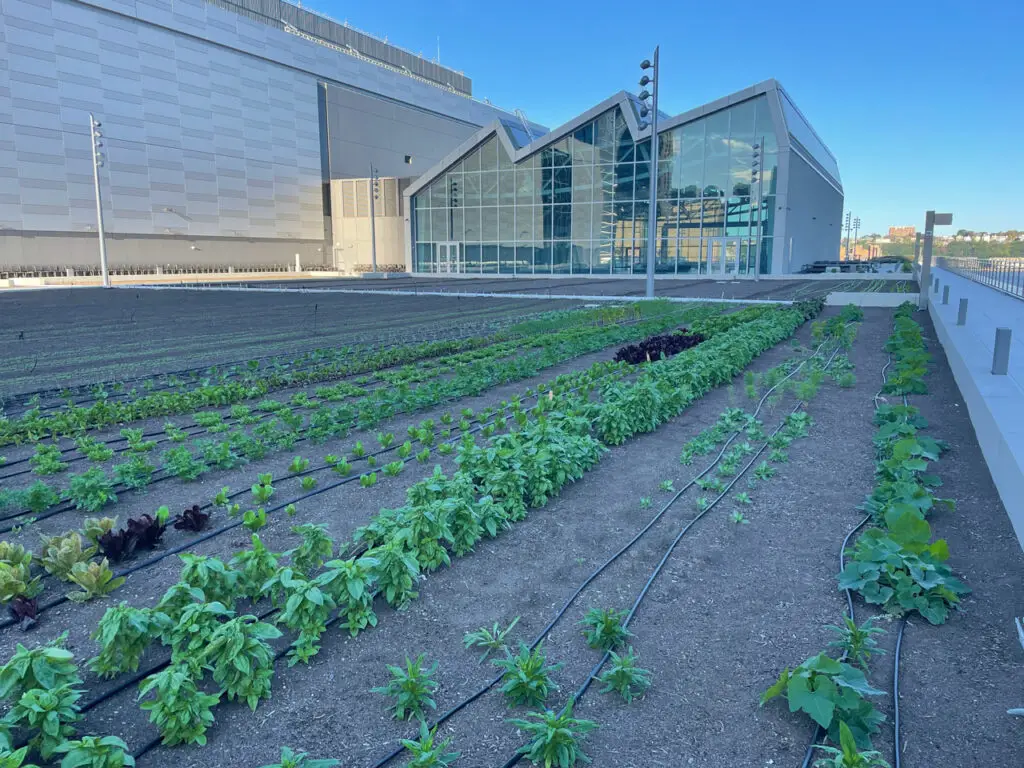Green Roof Manufacturers List & Website Directory
By Roof Online Staff • Last updated April 5, 2024
Return to the Roofing Manufacturer Directory Index

Green roofs, also known as living roofs, eco-roofs, and, most technically, as vegetative roof systems, are roofing systems that are either partially or completely covered with vegetation and a growing medium, installed over a waterproofing membrane. Green roof systems are typically 4 to 8 inches thick and include components such as root barriers, drainage mats, filter fabric, and irrigation systems.
Green roofs can be extensive, with a shallow layer of soil, simpler plantings, and lower maintenance needs, or they can be intensive, resembling traditional gardens with deeper soil and a wide variety of plants requiring more attention and care. The load capacity of the roof structure is a big consideration when deciding what type of green roof to install. Vegetative roof systems can weigh anywhere from 10 pounds to over 30 pounds per square foot, and they are especially heavy when saturated after a heavy rain.
Reasons for Installing a Green Roof:
- Environmental Benefits: Green roofs can help reduce the urban heat island effect in a couple of ways: they absorb less heat than traditional roofing materials, and the process of transpiration, by which the plants cool themselves, also cools the surrounding environment. They also help manage stormwater runoff, acting as a holding reservoir which reduces the burden on urban storm drainage systems.
- Energy Efficiency: By providing an insulating barrier above the building, green roofs reduce the amount of heat that enters the building and thus the energy needed for cooling.
- Biodiversity: They can create habitats for various bird species, insects, and other wildlife, increasing urban biodiversity.
- Aesthetic and Recreational Space: A nicely-designed green roof simply looks good; green roofs can enhance the aesthetic appeal of buildings and provide recreational space for a building’s occupants.
- Air Quality: The plants on green roofs can capture airborne pollutants and atmospheric deposition, improving air quality.
- Roof Life Expectancy: By protecting the roofing materials from extreme temperature fluctuations and UV radiation, green roofs can extend the lifespan of the roof membrane.
Important Considerations Before Installation:
- Structural Assessment: It’s very important to make sure that the building can support the additional weight of a green roof, especially when considering a thicker, heavier intensive green roof system.
- Waterproofing: A high-quality, durable waterproofing membrane is essential in order to prevent leaks. Roof leaks in green roof systems can be extremely hard to pinpoint and repair. Roofers will not be able to see the roof membrane, so finding a leak in a green roof means a lot of guesswork and will require the removal and reinstallation of sections of the vegetation and drainage layers while trying to find the precise leak location. It can cost much more than twice as much to repair a leak in a green roof than a leak in a traditional roof.
- Drainage: Proper drainage must be in place to prevent ponding water on the roof, which can damage both the plantings and the building structure.
- Access and Maintenance: Even low-maintenance green roofs require some upkeep. Access routes for maintenance personnel should be planned for.
- Local Climate and Plant Selection: The choice of plants should be appropriate for the local climate and roof conditions (e.g., sun exposure, wind levels).
Importance of Choosing a Good Manufacturer:
- Quality of Materials: A reputable manufacturer will provide high-quality materials that will enhance the performance of the green roof.
- System Compatibility: All components of the green roof system (waterproofing, drainage, growing medium, plants) must work together properly, which is more likely when these components are sourced from a manufacturer with a respectable amount of experience producing and overseeing the installation of green roof systems.
- Technical Support: Reputable manufacturers will have technical departments that offer design and technical support to assist you in making sure your green roof is installed correctly and functions as intended.
- Warranty and Reliability: A reputable manufacturer will stand behind their products with warranties and customer support in case you have problems with your roof.
- Innovation: Leading manufacturers often invest in research and development, offering innovative designs and products that can improve the performance and benefits of green roofs.
Selecting an experienced green roof manufacturer with a good reputation will help you ensure that all components are compatible, that the system will meet performance expectations, and that any issues will be promptly addressed.
*****
If you represent a reputable and qualified vegetative roof system manufacturer and feel that we’ve overlooked your company, feel free to contact us to ask to be added to this list.
Green Roof Manufacturers List
- American Hydrotech, Inc.
- Barrett Company
- Carlisle SynTec
- Columbia Green Technologies
- GAF Materials Corporation
- Green Roof Blocks
- Green Roof Plants
- Henry Company
- Holcim Elevate (formerly Firestone Building Products)
- LiveRoof
